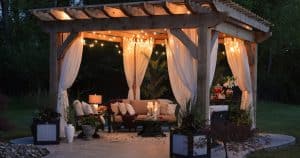Choosing the right commercial shade for a property in Dallas-Fort Worth feels a little like picking furniture for your backyard—except it has to survive blistering July sun, sudden storms, and keep customers or tenants comfortable year after year. You want something that looks great, works hard, and won’t need constant babysitting. Let me explain how to move from a pretty sketch to a shade solution that actually lasts and serves your business or multi-family property well.
Contents
- 1 Who this is for — yes, you
- 2 Design matters — look good and work harder
- 3 Materials and durability — what stands up to Dallas heat
- 4 Engineering, wind loads, and codes — boring but vital
- 5 Functionality — more than shade: lights, motors, and practical details
- 6 Budget, lifespan, and return on investment — how to think about cost
- 7 Choosing a local partner — why Dallas expertise matters
- 8 Quick checklist before you sign
- 9 Ready to make shade work for you?
Who this is for — yes, you
This piece is for property owners, facility managers, property developers, and anyone who gets handed the “shade problem” at a commercial site in DFW. If you’re supervising an apartment complex, a restaurant patio, or the entrance to an office building, this helps. You’ll get clear, practical guidance on design, Materials, engineering, and long-term upkeep—without a salesman’s hard sell.
Design matters — look good and work harder
Good design isn’t just about aesthetics. It’s about how a structure tames sunlight, routes rain, and fits your brand. You can have a sleek Pergola that reads modern-industrial, or a fabric canopy that feels relaxed and casual. The same shade can be dramatic or discreet, depending on proportions, color, and texture.
Here’s the thing: sun angles in DFW change fast through the seasons. A canopy that blocks midday sun in July might leave your winter seating too dark. Designers use solar orientation, local sun-path charts, and simple shading studies to decide overhangs and louvers. Ever notice how Southern porches have deep eaves? There’s a reason—practical design traditions matter.
Materials and durability — what stands up to Dallas heat
You can spend less upfront and pay more later. Or you can spend a bit more now and almost forget about it. Honestly, that trade-off matters.
| Material | Pros | Cons |
|---|---|---|
| Aluminum (frames) | Lightweight, rustproof when powder-coated, low maintenance | Can dent under impact; surface coating matters |
| Steel (frames) | Very strong, great for high wind ratings | Needs galvanizing or painting to prevent corrosion |
| Shade fabrics (Sunbrella, Coolaroo) | UV-stable, breathable or waterproof options, lots of Colors | Fabrics age; seams and tension points need inspection |
For fabrics, we often recommend brands like Sunbrella for colorfastness and warranty, or performance meshes for airflow and less wind load. Tensioned membrane systems are great when you need dramatic spans and less support—but they require precise installation and proper drainage design.
Engineering, wind loads, and codes — boring but vital
Here’s the boring part, but stick with me; this saves money and headaches. Structures in commercial settings usually need engineered drawings stamped by a licensed engineer. That’s not optional in most municipalities around DFW. Wind-load requirements, attachment to the building, and foundation size all tie into safety and permit approval.
You might be surprised: a lightweight fabric canopy could fail under gusts if anchors aren’t sized correctly. Or a wood pergola could look charming but warp and split unless properly detailed and sealed. Engineering prevents those “oh no” moments.
Functionality — more than shade: lights, motors, and practical details
Shades today do more than block sun. Motorized louvered systems (you’ve probably seen Somfy-driven installations), integrated LED lighting, and rain-sensing retractable canopies let spaces work longer and earn their keep. Installed sensors can retract a canopy automatically before a storm. That’s real peace of mind.
Maintenance is part of the story—cleaning schedules, lubrication of moving parts, and inspection of tensioned fabric all extend service life. A written maintenance plan and clear warranty terms make future budgeting easier; and honestly, fewer surprises make everyone happier.
Budget, lifespan, and return on investment — how to think about cost
Price and quality aren’t linear. A cheap install may look fine for a season or two, but replacement costs add up. Consider:
Initial cost: material, labor, engineering, permits.
Operating cost: maintenance, repairs, cleaning.
Value: increased usable outdoor area, tenant satisfaction, energy savings from reduced solar gain.
Think of a well-designed shade as an investment. A shaded patio at a restaurant can mean more covers and longer hours. A covered entrance at an office or medical building improves accessibility and reduces HVAC loads slightly—little wins add up.
Choosing a local partner — why Dallas expertise matters
Local knowledge matters. You want a contractor who knows DFW permit quirks, municipal inspection expectations, and where the gusts come from. Ask for portfolios of local work, references, and warranty terms. Good partners talk through trade-offs—materials versus lifecycle cost, or a retractable system versus a fixed canopy—and they explain why they’re recommending what they are.
You know what? It’s also about chemistry. If the person you’re hiring doesn’t listen to how you plan to use the space, you’ll end up with a beautiful structure that doesn’t serve your needs. That happens more often than it should.
Quick checklist before you sign
- Scope: Are lighting, drainage, and electrical work included?
- Warranty: What’s covered and for how long?
- Timeline: What’s the expected schedule and permit timeline?
- Maintenance: Who’s responsible for inspections and upkeep?
- References: Can they show nearby projects and client contacts?
Ready to make shade work for you?
If you’re in Dallas-Fort Worth and want a shade that’s designed for the heat, built for wind, and styled for your property—let’s talk. We handle design, engineering, permits, and installation so you get a finished product that’s dependable and beautiful.




